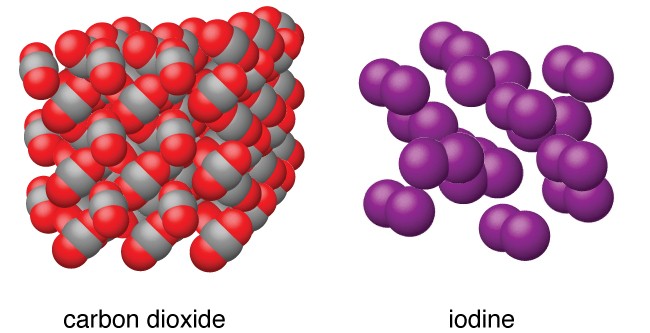Molecular Solids
Referring to molecular solids, matters’ elementary particles are molecules. Molecules exist as they are firmly packed and arranged to give rise to the formation of molecular solid. Moreover, molecular solids are separated into 3 basic categories as per the molecules’ nature:
- Polar Molecular Solids
- Non-polar Molecular Solids
- Hydrogen-Bonded Molecular Solids
Polar Molecular Solids
In the solid substances in which molecules are togetherly held with robust dipole-dipole forces, they are called the Polar Molecular Solids.
To form a molcules, atoms are combined which have different nature, let’s say, atoms of oxygen and sulphur are combined to sulphur dioxide (SO2) which is known as the polar molecular solid.
1. Polar Molecular Solids represents the below-mentioned properties:
- Polar Molecular Solids are flexible and soft in nature
- Polar Molecular Solids conducts no electricity as they can be called as insulators
- In comparison to Non-Polar Molecular Solids, generally, the melting point is higher of Polar Molecular Solids
- The existence of these type of molecyular solids in in gaseous and liquid state at normal room temperature and standard room pressure.
Eg: (NH3) Ammonia and (SO2) Sulphur Dioxide
2. Non-polar Molecular Solids
The solid objects in which molecules are formed of the identical types of atoms are known Non-Polar Molecular Solids. Non-Polar Molecular Solids’ dipole moment is zero plus the action of forces are not so strong London dispersion forces in between the constituent molecules.
Non-Polar Molecular Solids’ characteristics are mentioned below:
- This type of Molecular Solid is soft
- They are non-conductors of electricity
- Non-Polar Molecular Solids consists of low melting point
- They have stability in the gaseous and liquid state at standard room temperature and pressure.
Eg: Hydrogen (H2), Iodine (I2), and Chlorine (Cl2)
The Boiling and Melting Points of Crystalline Solids
| Type of Crystalline Solid | Eg. Formulas | Melting Point in Degree Celsius | Normal Boiling POint in Degree Celsius |
| Molecular | I2 | 114 | 184 |
| NH3 | -78 | -33 | |
| H2O | 0 | 100 |

Fig : Molecular structure of I2 and CO2
3. Hydrogen-Bonded Molecular Solids
The forces present are known to be responsible for molecular attraction in Hydrogen-Bonded Molecular Solids, which are called Hydrogen Bonds. The melting and boiling points of this type of molecular solid are much higher as compared to that of polar and non-polar type of molecular solids.
Hydrogen Bonded Molecular Solids are having polar covalent bonds that exist between F and H; N or O atoms.
The strong bond of hydrogen binds or firmly holds together molecules of these types of solids such as H2O (ice).
Hydrogen-Bonded Molecular Solids’s characteristics:
- Hydrogen-Bonded Molecular Solids are soft liquids or volatile liquids at standard room temperature and pressure
- They are non-conductors of electricity or can be known as the insulators
Eg: Ice (H2O)
